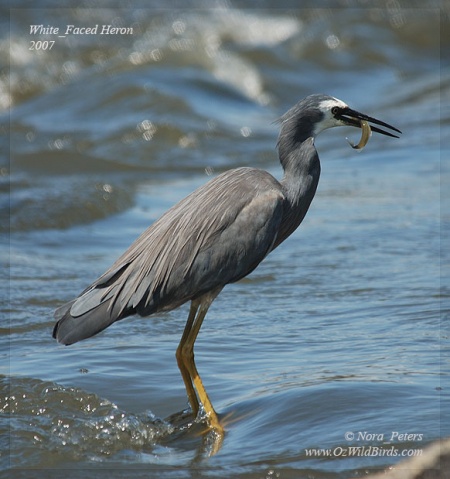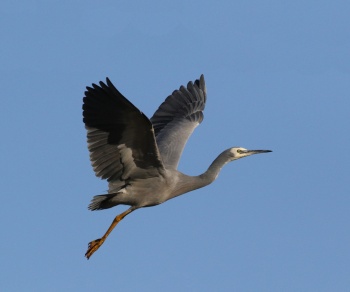- Egretta novaehollandiae
Ardea novaehollandiae
Identification
58–69 cm (22¾-27¼ in); a slender, graceful heron
- Bluish-grey overall plumage
- Yellow legs
- Long, slim neck
- Pointed greyish-black bill
- White face
Breeding birds have long feathers (nuptial plumes) on the head, neck and back.
Variations
North-west Australian birds are darker and separated as parryi.
Distribution
Breeds in southern New Guinea, New Caledonia, much of Australia except the arid interior, Tasmania and New Zealand where now found throughout North and South Islands and also on some smaller islands.
Largely resident but with much wandering and makes regular movements away from on the coast in New Zealand.
Vagrants reported in the arid interior of Australia and on many islands including Sulawesi, the Moluccas and Timor, the Kai and Aru Islands off New Guinea, and Lord Howe Island, the Kermadecs, Auckland, Campbell and Macquarie Islands.
Taxonomy
Subspecies
There are two subspecies[1]:
- E.n.novaehollandiae:
- Indonesia and Australasian region
- E.n.parryi:
- North West Australia
Habitat
Lakeshores and riverbanks, mangroves, shallow lagoons and on tidal mudflats and estuaries, sometimes rocky shores.
Behaviour
Breeding
The nest is an untidy shallow bowl, constructed from sticks and usually placed on a leafy branch.
Diet
They have a very varied diet, consisting of fish, aquatic insects, amphibians, and in New Zealand they take the introduced Tree Frog.
References
- Clements, J. F., T. S. Schulenberg, M. J. Iliff, D. Roberson, T. A. Fredericks, B. L. Sullivan, and C. L. Wood. 2016. The eBird/Clements checklist of birds of the world: v2016, with updates to August 2016. Downloaded from http://www.birds.cornell.edu/clementschecklist/download/
- Handbook of the Birds of the World Alive (retrieved June 2017)
- Wikipedia
Recommended Citation
- BirdForum Opus contributors. (2024) White-faced Heron. In: BirdForum, the forum for wild birds and birding. Retrieved 11 May 2024 from https://www.birdforum.net/opus/White-faced_Heron





